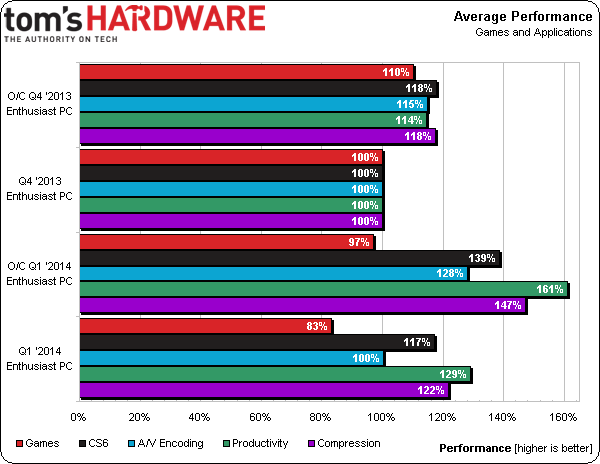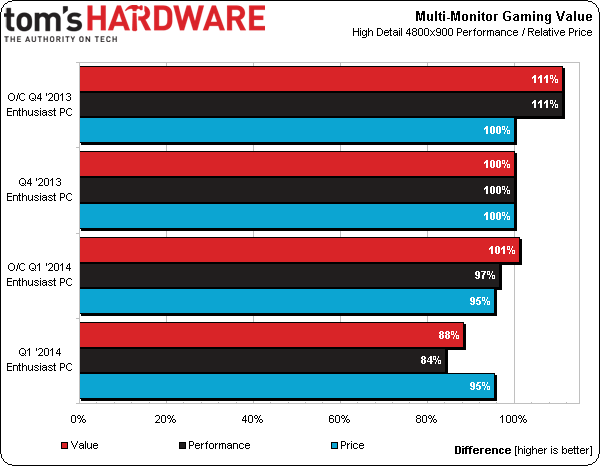System Builder Marathon, Q1 2014: Our New Enthusiast PC
A Core i7 And Flagship GPU Impress, Naturally
Despite an upgrade to Intel's Core i7-4770K and a $660 GeForce GTX 780 Ti graphics card, this quarter's enthusiast-oriented build is actually a little cheaper than my last effort, which included a Core i5 and two GeForce GTX 770s in SLI. Most of that comes from a lower-priced motherboard, less expensive storage, and a lower-output power supply.
The stock performance of this build suffered a bit because my memory kit defaulted to 1333 MT/s (Ed.: Which is by design; most enthusiasts know to enable XMP right out of the gate to correct this fail-safe of sorts). That bottleneck was mitigated by the overclocked configuration, which is where I triggered the XMP profile.
Here's the performance breakdown.
I'm a little surprised to see the Core i7-4770K merely matching the performance of my Core i5 at stock clocks in the A/V transcoding suite. But when you look at the individual benchmarks, it's clear that half were penalized for my memory setting. The other half actually did run faster. And the issue was obliterated after a bit of tweaking, giving this quarter's machine a notable advantage in processor-limited metrics.
We also see that one GeForce GTX 780 Ti isn't as fast as two 770s in SLI. Again, no shock there. Let's dig a little deeper into the gaming numbers to see how the match-up shakes out at 1920x1080 and Surround resolutions:
At 1920x1080, the GeForce GTX 780 Ti does a much better job of keeping up with the two GeForce GTX 770s in SLI. When the resolution increases to 4800x900, the dual-GPU configuration walks away with a clear win. Not that I needed it, but this is more evidence to support my opinion that SLI makes the most sense in multi-display arrangements. Still, the GeForce GTX 780 Ti makes a good case for using a single-GPU flagship (so long as it's priced competitively) with just one screen. After all, it uses for less power and delivers almost identical performance.
As for the rest of the build, I'm pleased with the choices I made. Right now, I'm thinking it'd be interesting to see how a Core i5 with a couple of GeForce GTX 760s would compare, while saving a boatload of cash. I'm also pretty happy with the few components that I bought that don't affect the benchmark results, but still add appropriate pizazz to this mid-range machine without scraping the bottom of the barrel to keep it affordable. NZXT's Phantom 410 and LG's Blu-ray writer complement the rest of the go-fast gear nicely. More so now than ever before, the lucky reader who wins my machine is going to enjoy those premium add-ons.
All that's left now is seeing how my machine compares to Paul's budget build and Thomas' high-end setup in our Day 4 analysis. Bring it on, gentlemen!
Current page: A Core i7 And Flagship GPU Impress, Naturally
Prev Page Power And TemperatureGet Tom's Hardware's best news and in-depth reviews, straight to your inbox.
Don Woligroski was a former senior hardware editor for Tom's Hardware. He has covered a wide range of PC hardware topics, including CPUs, GPUs, system building, and emerging technologies.
-
envy14tpe Why a Galaxy GPU considering the company pulled out of US market? btw, nice work on the build.Reply -
bemused_fred I wish more builds would account for the cost of the OS. It can be a significant expense, especially when you're working with builds of $600 or less.Reply -
Dark Oopa wow, I didn't think there would be such a little difference in gaming.In fact, the difference is so small that with all the inherent problems of the SLI, the new rig is always the better choice.Reply -
redgarl Multi-gpu problems are always overly exagerated. I am using multi-gpu platforms for almost 5 years and the gain in fps over the UNOTICEABLE and overly exagerated stutering sweep away any disavantages.Folks, don't lure yourself, higher resolution demand multi-gpus. Single card is fine for anything around 1080p, more or less, but at 4K or 3 1080p monitors... your system is going to choke even with a 780 ti.Reply -
npyrhone Having 1600x900 resolution in the gaming charts serves only one purpose: to create the impression that there is not really a difference between the two builds, while in reality the later one is obviously inferior to the previous one.Reply -
vertexx It's a shame to completely remove the non-core components from the competition, but I understand why it's done here. A couple of ideas to throw out there:Reply
(1) You could include temperatures and acoustics performance in the overall assessment, given I think that is a big part of the case buying decision, and
(2) A way to factor in the intangibles (i.e. blu ray vs dvd, choice of SSD/HDD, etc), you could include a separate vote between this quarter's and last quarter's to see what the readers would choose for the best build given all the performance factors, aesthetics, and other components that do not contribute directly to performance. The reader's vote of this quarter vs. last quarter and/or an overall value winner for this quarter could be included in the final write-up.
I would also 2nd the vote for starting 4K testing. And also, why not 1440p? It seems those two resolutions are more relevant now in 2014 at the level of this competition than 1600x900 and 4800x900 resolutions. -
DarkSable I'm sorry, Tom's, but...You really need to stop misinforming the general public who comes here for your articles and doesn't read the forums in depth.You go with an i7 for the "performance benefits," which are nonexistent for gaming... except that this rig is aimed at gaming. I would have much, much rather seen an i5, with a note explaining that an i7 is a good upgrade if you're doing these sorts of things, but isn't helpful if you're building a gaming computer.There are wayyyy too many new builders out there who think that the i7 is better than the i5 and who are just wasting their money, and you aren't helping them or correcting that misinformation - rather, you're just reinforcing it further.Reply -
nekromobo I would really like to see mATX and mini-itx versions of this article, pretty please :)Reply -
vertexx Reply
Hmm.... What percentage of the performance measures in this article are for gaming?12959893 said:I'm sorry, Tom's, but...You really need to stop misinforming the general public who comes here for your articles and doesn't read the forums in depth.You go with an i7 for the "performance benefits," which are nonexistent for gaming... except that this rig is aimed at gaming. I would have much, much rather seen an i5, with a note explaining that an i7 is a good upgrade if you're doing these sorts of things, but isn't helpful if you're building a gaming computer.There are wayyyy too many new builders out there who think that the i7 is better than the i5 and who are just wasting their money, and you aren't helping them or correcting that misinformation - rather, you're just reinforcing it further.



